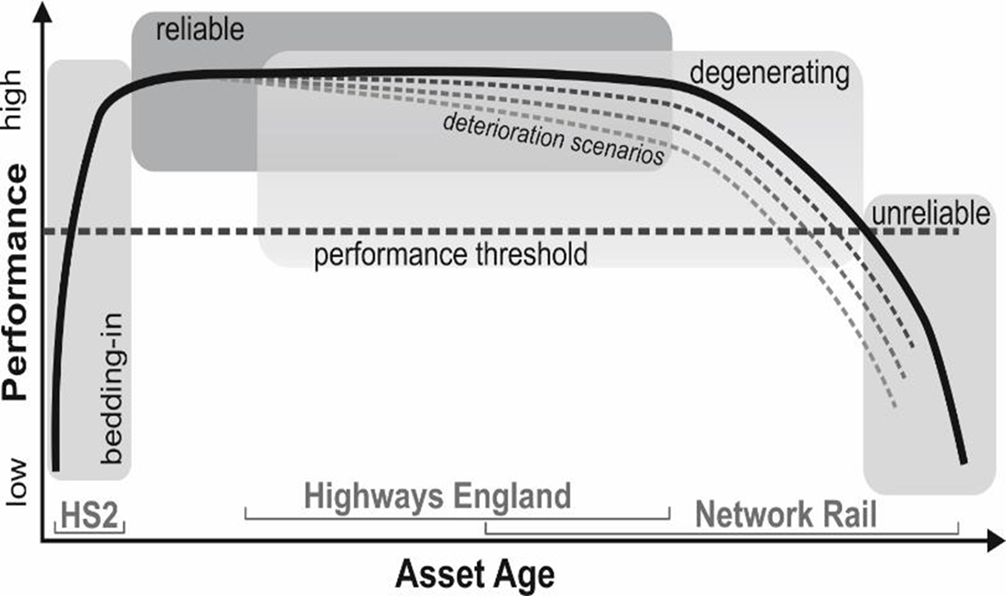Dr Kevin Briggs is a Lecturer in Geotechnical Engineering and RAEng Industrial Fellow in ‘Railway Infrastructure Resilience’ (2017/18).
Transport infrastructure consists of a wide range of highly visible structures including bridges, tunnels and overhead gantries for signage and lighting. It also includes largely invisible infrastructure such as earthworks. Earthworks are the structures that cut through hills (cuttings) or raise the ground (embankments) to literally form the foundation of our road, rail and canal transport infrastructure. Fortunately, most transport infrastructure is working effectively and is therefore invisible to transport users. However, the projected performance of these structures must be visible to those who own, operate and maintain them.
The continual maintenance, renewal and repair of transport infrastructure is costly. However, the cost of failure is even higher. Thankfully the deterioration and catastrophic failure of structures, such as the motorway viaduct collapse in Genoa in August 2018, are rare. But the long and linear nature of transport routes mean that even small, non-fatal failures are an Achilles Heel for the wider network. Even small failures can lead to route closures, delays and severe disruption for transport users. To prevent a loss of performance, infrastructure requires regular maintenance and renewal, which costs time and public money. Highways England spent £20M repairing cutting slopes in 2010. Network Rail spend more than £117M on earthworks maintenance annually.
In the UK we have inherited an extensive railway network which was constructed by the Victorians and helped to fuel the industrial revolution. This involved huge engineering feats – approximately 54 million m3 of soil was excavated, mostly by hand, to construct earthworks for the nine main line railways between 1834 and 1841. These old railway earthworks are slowly deteriorating and require constant patches and repairs. Earthwork failures occur regularly on the Victorian-aged rail network (there were 143 earthworks failures in 2015, which equates to two per week), while highway earthwork failures are likely to increase as they continue to age. We are heavily reliant on these old earthworks, which we know are vulnerable to failure but we cannot afford to completely replace and can barely afford to re-actively repair.
Why do earthworks fail? Many earthworks are old, they are degrading and some of them are vulnerable to loading induced by increased traffic volume, constant use and a changing environment. For example, failure rates can increase during prolonged wet periods; the ground becomes saturated and heavy rainfall events can trigger slope failures. Ageing causes the strength and stiffness of the ground to reduce with time. Increased traffic loading and volume reduces the time available for inspection, maintenance and repairs.
The engineering solutions to these threats are not complicated and have changed little in recent history. But they are expensive. For example £4M of stabilisation works were required following an earthwork failure and train derailment near Watford in 2016. Investment must be balanced between new-build (e.g. HS2), upgrades and the repair of existing infrastructure. It is unlikely that there will be sufficient funds for everything we need, hence the National Infrastructure Commission (NIC) and the Infrastructure Projects Authority (IPA) were established in 2016; the NIC to assess our infrastructure needs and make a prioritised plan for investment, and the IPA to support the successful delivery of priorities.
The process of prioritisation and the targeted renewal of transport infrastructure will enable cost savings and reduce transport disruption. Much like an old car, the likelihood of a breakdown or failure is significantly reduced by regular inspections, maintenance and renewals. Evidence shows that the proactive maintenance of earthworks costs ten times less than planned renewals, which in turn cost ten times less than the reactive repair of failures. We can spend less money on earthworks and other transport infrastructure, increase reliability and reduce disruption to the travelling public. So how can this be achieved?

One approach to forecasting is to produce deterioration curves showing infrastructure performance over time. This can be considered at the asset scale (e.g. earthwork, bridge, tunnel) or at the network scale (e.g. the London to Bristol railway line or the M4 motorway). Figure 1 shows how major UK transport infrastructure might map on to a deterioration curve. Newer structures such as those supporting HS2 would spend some time bedding-in, before achieving full performance. Highways earthworks, which are approximately 60-70 years old, can be considered to be at peak performance; while railway earthworks, which are now at least 100-150 years old, are deteriorating and reducing their performance. By mapping an infrastructure asset on to a deterioration curve it will be possible to forecast its performance and plan the optimal timing of interventions or maintenance.
How can these curves be populated? Individual structures such as earthworks present an Achilles Heel to the performance of transport infrastructure networks. Therefore, it is necessary to understand the factors influencing the performance of individual structures and to understand the implications of asset failure at the network scale. Both of these approaches must be combined to define the current performance of an infrastructure asset and then forecast the performance of both the asset and the transport network.
An example of this challenge in the context of infrastructure earthworks is being addressed by the EPSRC-funded ACHILLES programme, which brings together university researchers, infrastructure owners and their consultants. A vast amount of information is held by infrastructure owners, which includes historical records and long-term performance data for transport networks and individual assets. Researchers will use this data, informed by scientific understanding, to produce deterministic models of individual earthwork behaviour and statistical tools for the analysis and integration of these large and complex datasets. An industry advisory group and expert advisory board will help steer this research to produce deterioration scenarios and deterioration curves that can be used by government, infrastructure owners and their consultants.
It will be a challenge to produce deterioration curves for transport infrastructure assets. But the curves will enable a shift in how transport infrastructure is operated and maintained over its lifespan. This will influence the long-term planning and full-life costing of new schemes such as Crossrail 2 and the Northern Powerhouse linking the major Northern cities. The curves will make the long-term deterioration of infrastructure more visible to planners, financers and other decision makers. This will ensure that transport infrastructure assets continue to perform and that disruptive failures are reduced; keeping transport infrastructure invisible to transport users.
Respond




